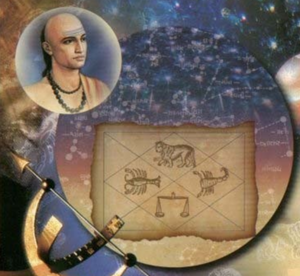Talk:Astronomers Āryabhaṭa and Varāhamihiraḥ
By Vishal Agarwal
Āryabhaṭa, one of the foremost astronomers and mathematicians of ancient India, was born in 476 CE. Although his exact birthplace is uncertain, historical records confirm that he served as the head of a prominent university. His celebrated work, the Āryabhaṭīya, contains numerous discoveries in mathematics and astronomy that have been verified by modern science.
Among the remarkable contributions of Āryabhaṭa are the following:
- In geometry, he calculated the value of pi (π) as 3.1416—an approximation astonishingly close to the modern value.
- He correctly stated that the moon does not emit light of its own but shines due to sunlight reflected from its surface.
- He accurately described a lunar eclipse as the result of the earth passing between the sun and the moon, blocking the moon’s illumination.
- He calculated the time taken for the earth to rotate on its axis as 23 hours, 56 minutes, and 45.1 seconds—nearly identical to the modern measurement of 23 hours, 56 minutes, and 45.091 seconds.
- He provided a sine table, laying the foundation for the branch of mathematics known as trigonometry.
- Most notably, he declared that it is the earth that revolves around the sun, not the other way around—a fact recognized in Europe only a thousand years later by Nicolaus Copernicus (1473–1543 CE).
Another eminent scholar of ancient India was Varāhamihira, who lived in Ujjayinī (modern Ujjain) from approximately 499 to 587 CE. He was a master of astronomy and astrology and authored one of the world’s earliest encyclopedic works, the Bṛhatsaṃhitā, comprising about 4,000 verses. This monumental text includes detailed knowledge on astronomy, meteorology, architecture, geography, botany, gemology, perfumery, and cosmetics.
An especially striking aspect of Varāhamihira’s work is his assertion that the earth is spherical. While today this is universally accepted, for many centuries large parts of the world—including medieval Europe—believed the earth to be flat. For instance, during the voyage of Christopher Columbus in 1492 CE, many church leaders still maintained that ships could fall off the edge of the world if they sailed too far west.
Centuries earlier, however, Varāhamihira and other Vedic scholars had already affirmed the earth’s spherical nature—a concept also echoed in some Greek writings, such as those of Aristotle in the 4th century BCE. Varāhamihira’s synthesis of astronomy, cosmology, and practical sciences stands as a testament to the scientific spirit of India’s classical age.

